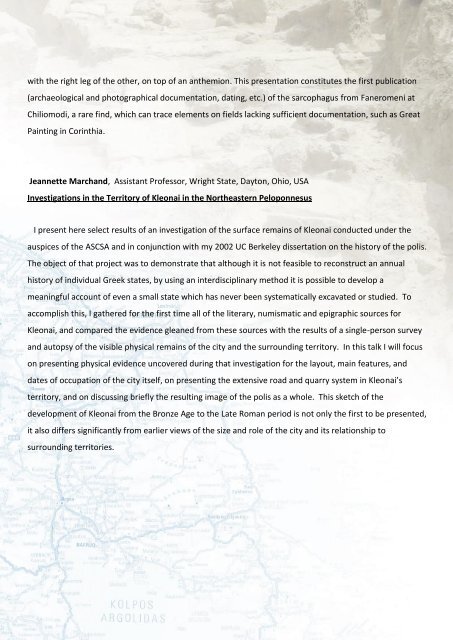ABSTRACTS - The American School of Classical Studies at Athens
ABSTRACTS - The American School of Classical Studies at Athens
ABSTRACTS - The American School of Classical Studies at Athens
Create successful ePaper yourself
Turn your PDF publications into a flip-book with our unique Google optimized e-Paper software.
with the right leg <strong>of</strong> the other, on top <strong>of</strong> an anthemion. This present<strong>at</strong>ion constitutes the first public<strong>at</strong>ion<br />
(archaeological and photographical document<strong>at</strong>ion, d<strong>at</strong>ing, etc.) <strong>of</strong> the sarcophagus from Faneromeni <strong>at</strong><br />
Chiliomodi, a rare find, which can trace elements on fields lacking sufficient document<strong>at</strong>ion, such as Gre<strong>at</strong><br />
Painting in Corinthia.<br />
Jeannette Marchand, Assistant Pr<strong>of</strong>essor, Wright St<strong>at</strong>e, Dayton, Ohio, USA<br />
Investig<strong>at</strong>ions in the Territory <strong>of</strong> Kleonai in the Northeastern Peloponnesus<br />
I present here select results <strong>of</strong> an investig<strong>at</strong>ion <strong>of</strong> the surface remains <strong>of</strong> Kleonai conducted under the<br />
auspices <strong>of</strong> the ASCSA and in conjunction with my 2002 UC Berkeley dissert<strong>at</strong>ion on the history <strong>of</strong> the polis.<br />
<strong>The</strong> object <strong>of</strong> th<strong>at</strong> project was to demonstr<strong>at</strong>e th<strong>at</strong> although it is not feasible to reconstruct an annual<br />
history <strong>of</strong> individual Greek st<strong>at</strong>es, by using an interdisciplinary method it is possible to develop a<br />
meaningful account <strong>of</strong> even a small st<strong>at</strong>e which has never been system<strong>at</strong>ically excav<strong>at</strong>ed or studied. To<br />
accomplish this, I g<strong>at</strong>hered for the first time all <strong>of</strong> the literary, numism<strong>at</strong>ic and epigraphic sources for<br />
Kleonai, and compared the evidence gleaned from these sources with the results <strong>of</strong> a single-person survey<br />
and autopsy <strong>of</strong> the visible physical remains <strong>of</strong> the city and the surrounding territory. In this talk I will focus<br />
on presenting physical evidence uncovered during th<strong>at</strong> investig<strong>at</strong>ion for the layout, main fe<strong>at</strong>ures, and<br />
d<strong>at</strong>es <strong>of</strong> occup<strong>at</strong>ion <strong>of</strong> the city itself, on presenting the extensive road and quarry system in Kleonai’s<br />
territory, and on discussing briefly the resulting image <strong>of</strong> the polis as a whole. This sketch <strong>of</strong> the<br />
development <strong>of</strong> Kleonai from the Bronze Age to the L<strong>at</strong>e Roman period is not only the first to be presented,<br />
it also differs significantly from earlier views <strong>of</strong> the size and role <strong>of</strong> the city and its rel<strong>at</strong>ionship to<br />
surrounding territories.

















